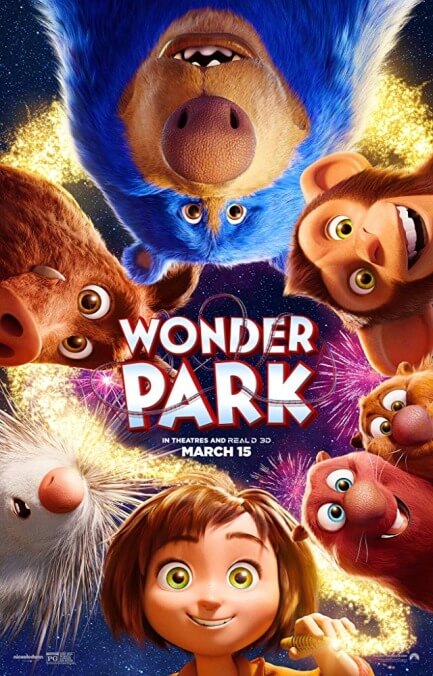At the animated Wonder Park, the view is lovely but the attractions don’t fit together

Wonder Park represents at least one milestone: Here, finally, is a computer-animated movie where the human characters are almost all cute and appealing, while the zany talking animals exist almost uniformly at an Illumination-grade level of ugliness. There are plenty of studio cartoons with irksome, overly insistent animal sidekicks, but rarely have would-be audience favorites felt so at odds with whatever else the movie is trying to do.
In fairness to these cuddly pests, it’s not entirely clear what Wonder Park is trying to do, though it has some lovely moments. In what feels like a succession of three or four prologues, June (Sofia Mali when she’s younger, Brianna Denski when she’s a little older) is introduced as an imaginative, enthusiastic tween who shares a creative bond with her encouraging mother (Jennifer Garner). Together, June and her mom spend a lot of time designing blueprints and models for an imaginary amusement park called Wonderland, brainstorming fantastical new rides and whimsical talking animals to operate them as June’s dad (Matthew Broderick) and plenty of neighborhood kids look on in awe. No one asks why June and her mom have so fully imagined a park’s merchandising program, but give them credit for both realism and attention to detail.
When her mom becomes seriously ill, June loses interest in their ongoing project, paralyzed with fear and frustration over the uncertainty that has been introduced into her young life. But while attempting to escape from math camp, June makes a magical discovery: Somewhere in the woods, far from her home, Wonderland has manifested itself—and has fallen into disrepair without her attention. It’s also been overrun with “chimpanzombies,” spiteful little stuffed chimps who were originally designed as dolls in the image of park impresario Peanut (Norbert Leo Butz), now hellbent on destroying everything in their path.
The park itself, with its impossible rides tipping over, exploding, or lying dormant, is beautifully designed in its desiccation—an unusually lush sci-fi-like landscape for a contemporary children’s fantasy. (It’s so cool-looking that the idea of repairing it into a functioning business is faintly depressing.) This well-realized environment is populated by a small band of mascots: Greta (Mila Kunis), an all-business wild boar; Boomer (Ken Hudson Campbell), a narcoleptic bear; Steve (John Oliver), a porcupine who inflects his every line exactly like, well, John Oliver in full preen; and a couple of chattering beaver siblings (Kenan Thompson and Ken Jeong). Together, they generate a lot of uninspired, superfluous shtick. The jokes that do land have little to do with the animals; there’s a great cutaway to how June imagines her father would live if left alone to his own devices: nonchalantly guzzling expired milk, floor littered with golf balls.
Among the mascots, only Peanut really has a place within Wonderland’s function as an alternately heartfelt and muddled metaphor for June’s emotional turmoil. Her pain over the possibility of losing her mother is palpable, sometimes raw, and often affecting. The people in her life don’t seem certain about how to deal with her state of mind, and frankly, neither do the filmmakers. Sometimes Wonder Park seems ready for an Inside Out turn toward accepting sadness as part of life, but it’s hard to make that point when also arguing that June must dedicate herself to saving a made-up amusement park. Like the recent Lego Movie 2, the movie makes surprisingly few allowances for how kids change as they grow up and encounter more of life’s complexities. Neither movie wants to suggest out loud that these changes are a bittersweet inevitability, instead painting them as a set of symptoms requiring whimsical (if sensitive) treatment.
The mixed messages at hand don’t have to matter; no one is waiting on Wonder Park to deliver instructions about how to best live their life. But on a more basic logistical level, the movie is obscured by weird bits of fuzz. Why does the plot bother with sending June off to math camp if it’s just an excuse to run away and stumble across the park? Why does the movie imagine that audiences of any age will be invested in the lusty feelings that Steve (to reiterate, a porcupine) maintains for Greta (to reiterate, a wild boar)? Why is the park called Wonderland if the movie is called Wonder Park? Who was in charge of this buildup of small but puzzling decisions?
Wonder Park’s credits make it all too easy to infer that ultimately no one was; the movie literally has no credited director. The original director, Pixar animator Dylan Brown, was fired toward the end of production due to misconduct claims, and Paramount has settled on leaving that byline blank. Of course, most studio cartoons are heavily collaborative efforts, and Brown would have been pretty far into production when he was let go; it’s not as if the movie was actually left adrift when he departed. But even before it gets to its conspicuously director-less end credits, Wonder Park has the unmistakable air of a promising movie no one has taken full responsibility for polishing into a good one.